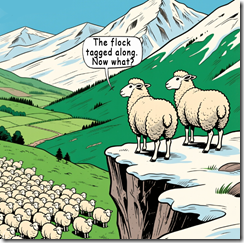AI Spending Killing Jobs, Not AI Technology
November 21, 2025
 Another short essay from a real and still-alive dinobaby. If you see an image, we used AI. The dinobaby is not an artist like Grandma Moses.
Another short essay from a real and still-alive dinobaby. If you see an image, we used AI. The dinobaby is not an artist like Grandma Moses.
Fast Company published “AI Isn’t Replacing Jobs. AI Spending Is.” The job losses are real. Reports from recruiting firms and anecdotal information make it clear that those over 55 are at risk and most of those under 23 are likely to be candidates for mom’s basement or van life.

Thanks, Venice.ai. Pretty lame, but I grew bored with trying different prompts.
The write up says:
From Amazon to General Motors to Booz Allen Hamilton, layoffs are being announced and blamed on AI. Amazon said it would cut 14,000 corporate jobs. United Parcel Service (UPS) said it had reduced its management workforce by about 14,000 positions over the past 22 months. And Target said it would cut 1,800 corporate roles. Some academic economists have also chimed in: The St. Louis Federal Reserve found a (weak) correlation between theoretical AI exposure and actual AI adoption in 12 occupational categories.
Then the article delivers an interesting point:
Yet we remain skeptical of the claim that AI is responsible for these layoffs. A recent MIT Media Lab study found that 95% of generative AI pilot business projects were failing. Another survey by Atlassian concluded that 96% of businesses “have not seen dramatic improvements in organizational efficiency, innovation, or work quality.” Still another study found that 40% of the business people surveyed have received “AI slop” at work in the last month and that it takes nearly two hours, on average, to fix each instance of slop. In addition, they “no longer trust their AI-enabled peers, find them less creative, and find them less intelligent or capable.”
Here’s the interesting conclusion or semi-assertion:
When companies are financially stressed, a relatively easy solution is to lay off workers and ask those who are not laid off to work harder and be thankful that they still have jobs. AI is just a convenient excuse for this cost-cutting.
Yep, AI spending is not producing revenue. The sheep herd is following AI. But fodder is expensive. Therefore, cull the sheep. Wool sweaters at a discount, anyone? Then the skepticism of a more or less traditional publishing outfit surfaces; to wit:
The wild exaggerations from LLM promoters certainly help them raise funds for their quixotic quest for artificial general intelligence. But it brings us no closer to that goal, all while diverting valuable physical, financial, and human resources from more promising pursuits.
Several observations are probably unnecessary, but I as an official dinobaby choose to offer them herewith:
- The next big thing that has been easy to juice has been AI. Is it the next big thing? Nope, it is utility software. Does anyone need multiple utility applications? Nope. Does anyone want multiple utility tools that do mostly the same thing with about the same amount of made up and incorrect outputs? Nope.
- The drivers for AI are easy to identify: [a] It was easy to hype, [b] People like the idea of a silver bullet until the bullets misfire and blow off the shooter’s hand or blind the gun lover, [c] No other “next big thing” is at hand.
- Incorrect investment decisions are more problematic than diversified investment decisions. What do oligopolistic outfits do? Lead their followers. If we think in terms of sheep, there are a lot of sheet facing a very steep cliff.
Net net: Only a couple of sheep will emerge as Big Sheep. The other sheep? Well, if not a sweater, how about a lamb chop. Ooops. Some sheep may not want to become food items on a Styrofoam tray wrapped in plastic with a half off price tag. Imagine that.
Stephen E Arnold, November 21, 2025


